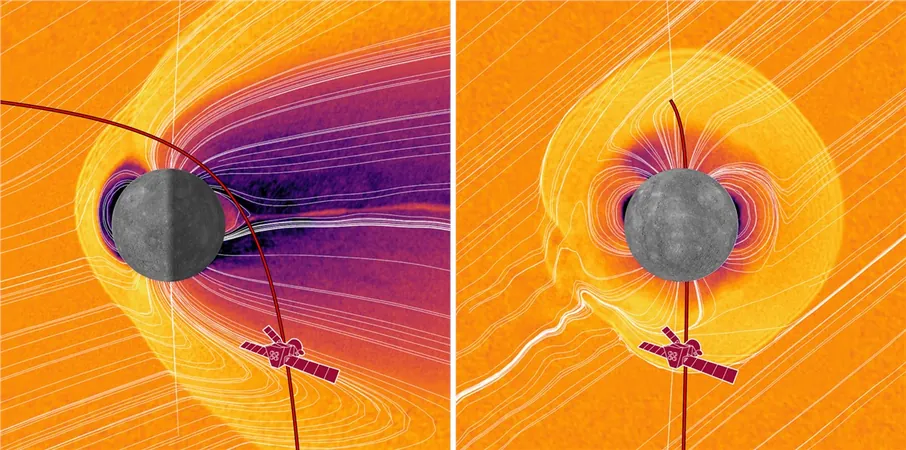
BepiColombo to Make Historic Sixth Flyby of Mercury
2025-01-07
Author: Olivia
BepiColombo to Make Historic Sixth Flyby of Mercury
On January 8, 2025, the highly anticipated BepiColombo mission, a collaboration between the European Space Agency (ESA) and the Japan Aerospace Exploration Agency (JAXA), will make its sixth and final flyby of Mercury, passing just 295 km above the planet's surface at precisely 06:59 CET (05:59 UTC). This pivotal moment in the spacecraft's journey is crucial not only for capturing stunning images of Mercury but also for conducting vital measurements of its environment, thereby calibrating scientific instruments before the official mission kicks off.
A Journey Six Years in the Making
BepiColombo is currently in the midst of an ambitious eight-year voyage to study the solar system's innermost planet. Over this period, the probe will perform a total of nine planetary flybys — one at Earth, two at Venus, and six at Mercury itself. Each flyby not only aids in maneuvering the spacecraft into the correct trajectory but also turns up new insights about the enigmatic planet. This upcoming flyby is particularly exciting because BepiColombo will meticulously examine Mercury's surface and surrounding space.
Dark Mysteries and Solar Secrets
Interestingly, BepiColombo will enter Mercury's night side during this flyby, spending over 23 minutes without direct sunlight. To maximize efficiency, mission operators at ESA's European Space Operations Centre (ESOC) will pre-warm the spacecraft the day before the flyby, ensuring that it conserves battery power during this eclipse-like phase. According to Ignacio Clerigo, Spacecraft Operations Manager, they will closely monitor battery levels and the temperature of all systems throughout the flyby.
This marks a unique aspect of the mission, as the spacecraft will also gather data using the Italian Spring Accelerometer (ISA) which will track accelerations due to the gravitational pull of Mercury and changes in solar radiation. This information is crucial as it will provide insights into the spacecraft's operational environment.
An Encounter with the Polar Shadows
One of the most intriguing aspects of this flyby is that BepiColombo's trajectory will take it directly over Mercury's north pole, allowing it to peer into craters that are perpetually shadowed and cooler than the sunlit regions, where temperatures can soar to a blistering 450 °C. Remarkably, earlier data from NASA's Messenger spacecraft suggests evidence of water ice within these deep, cold craters. This revelation poses one of BepiColombo's critical questions: Is there really water ice on the hottest planet in our solar system?
Incredible Features Await
During its flyby, BepiColombo's cameras will capture breathtaking images of several notable features on Mercury, including the permanently shadowed Prokofiev, Kandinsky, and Tolkien craters, as well as the massive Caloris Basin, one of the largest impact craters in the solar system. The detailed views and data collected during this mission will significantly enhance our understanding of these poorly explored regions, making it a historic moment for planetary science.
Uncharted Territories of Magnetic Fields
The sixth flyby will also allow BepiColombo to traverse areas of Mercury's unique magnetic and particle environment that have never been sampled before. The spacecraft will fly through regions rich in charged particles and will utilize its advanced scientific instruments, such as SERENA and MPPE particle analysers, to obtain critical measurements while cruising through these unexplored sectors.
What Lies Ahead
Launched on October 20, 2018, BepiColombo is poised to arrive in Mercury's orbit by late 2026, where it will split into two orbiters: ESA’s Mercury Planetary Orbiter (MPO) and JAXA’s Mercury Magnetospheric Orbiter (Mio). With science operations set to begin in early 2027, both orbiters will gather and analyze data over a nominal mission period of one year, with possibilities for extensions.
Excitement is palpable as scientists and enthusiasts alike anticipate the profound discoveries that this mission will unveil, transforming our understanding of Mercury and the early solar system.
Stay Tuned for Stunning Images!
Prepare for an astronomical visual feast, as the first images from this flyby are expected to be released on January 9, 2025. The world will be watching, as BepiColombo prepares to shine a light on the mysteries of Mercury, the planet that has intrigued scientists for centuries!



 Brasil (PT)
Brasil (PT)
 Canada (EN)
Canada (EN)
 Chile (ES)
Chile (ES)
 Česko (CS)
Česko (CS)
 대한민국 (KO)
대한민국 (KO)
 España (ES)
España (ES)
 France (FR)
France (FR)
 Hong Kong (EN)
Hong Kong (EN)
 Italia (IT)
Italia (IT)
 日本 (JA)
日本 (JA)
 Magyarország (HU)
Magyarország (HU)
 Norge (NO)
Norge (NO)
 Polska (PL)
Polska (PL)
 Schweiz (DE)
Schweiz (DE)
 Singapore (EN)
Singapore (EN)
 Sverige (SV)
Sverige (SV)
 Suomi (FI)
Suomi (FI)
 Türkiye (TR)
Türkiye (TR)
 الإمارات العربية المتحدة (AR)
الإمارات العربية المتحدة (AR)